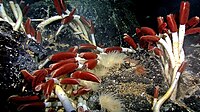
Photo from wikipedia
Abstract Our study presents a revision of the structural characteristics of the soft-bottom benthic communities in the Belgian Part of the North Sea (BPNS) and provides, for the first time,… Click to show full abstract
Abstract Our study presents a revision of the structural characteristics of the soft-bottom benthic communities in the Belgian Part of the North Sea (BPNS) and provides, for the first time, an insight into their functional characteristics. Compared to previous research, the dataset expanded considerably on a spatial and temporal scale (1994–2012). Five communities were identified, each with their own structural characteristics, indicator species, sediment properties and spatial distribution. The offshore area was dominated by the Hesionura elongata community (formerly Ophelia borealis), and although previously described by low diversity and abundance, this study shows that this community has the second highest sample diversity and moderate densities. Also, a new community, the Magelona-Ensis leei community, was found in very shallow water and characterized by low diversity and the dominance of the non-indigenous species E. leei. The structural characteristics and spatial distribution of the previously described Limecola balthica, Abra alba and Nephtys cirrosa community remained largely unchanged. Though structurally distinct, the communities overlap in some of their functional attributes. Analysis of biological traits revealed that in the coarser permeable sands, both the N. cirrosa and H. elongata community harbor more free living mobile individuals, causing diffusive mixing. The finer sand (A. alba, Magelona- Ensis leei) and muddy (L. balthica) communities hold more sessile, tube building and burrow dwelling species. Apart from diffusive mixing, sediment reworking in these finer sands occurs by surface deposition and downward convection. In combination with higher densities and biomass, this results in a higher bioturbation potential (BPc) for the Abra alba and Magelona-Ensis leei community. Finally, measures for functional diversity and redundancy were calculated, and were also highest in the Abra alba and Hesionura elongata community, thus demonstrating the importance of both communities for conservation purposes from a structural as well as a functional perspective. The analyses revealed that even in well-studied areas new data give new insights, with important consequences for management. Our study forms a benchmark for future ecosystem health status assessments in the framework of international and national nature management obligations such as the European Marine Strategy Framework Directive (MSFD), the Habitats Directive and the Marine Spatial Planning Directive.
Journal Title: Estuarine, Coastal and Shelf Science
Year Published: 2018
Link to full text (if available)
Share on Social Media: Sign Up to like & get
recommendations!